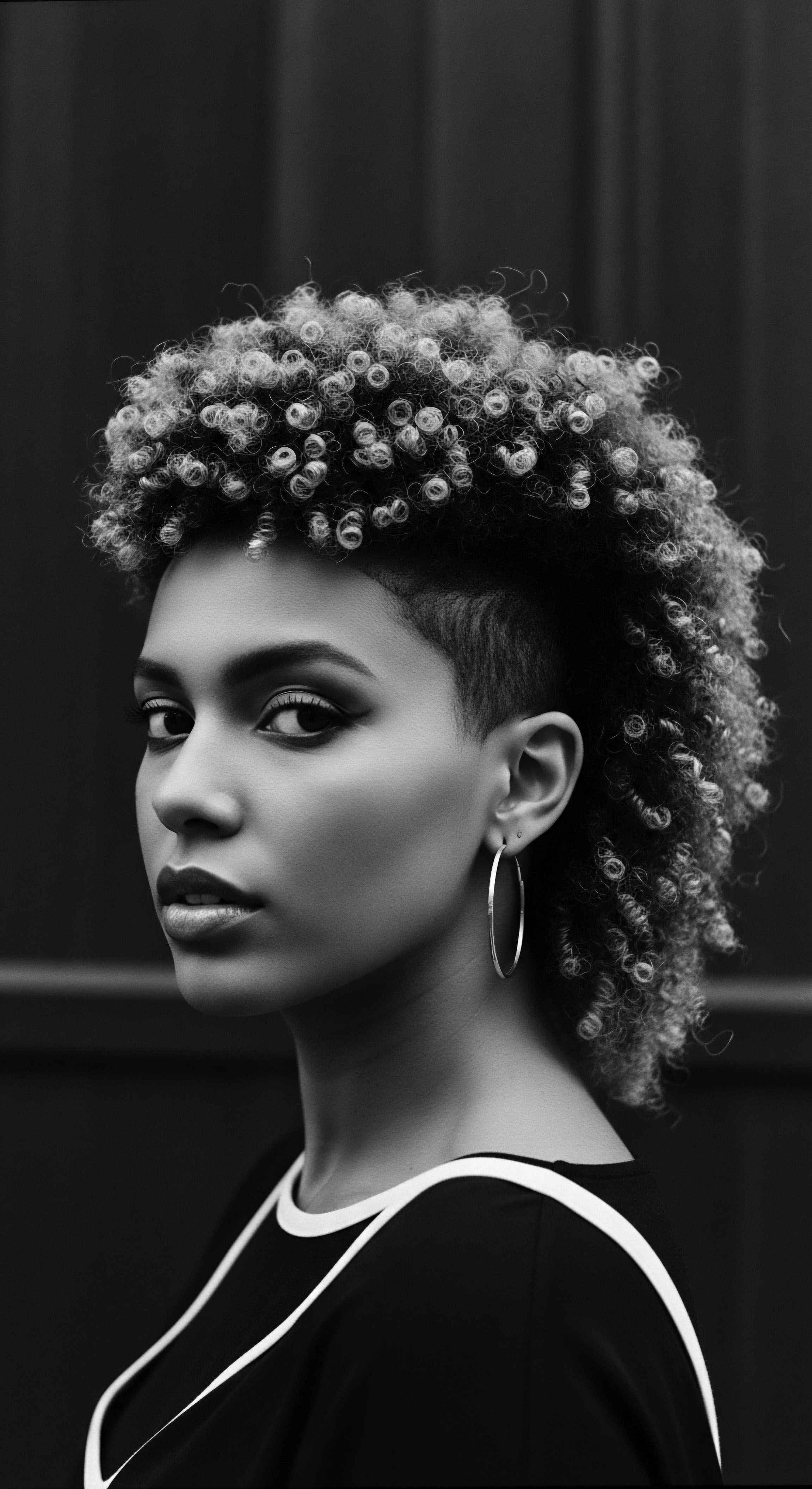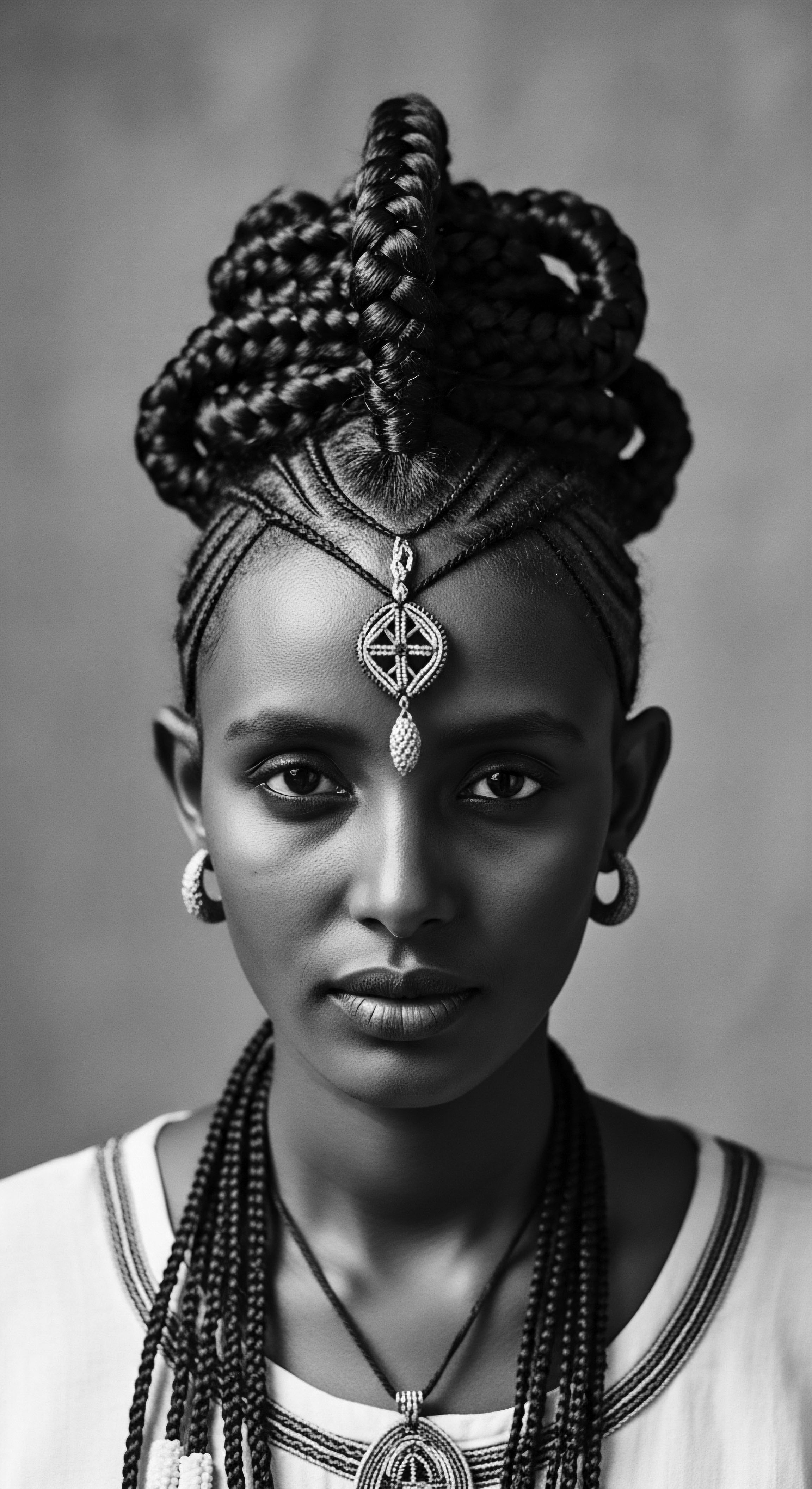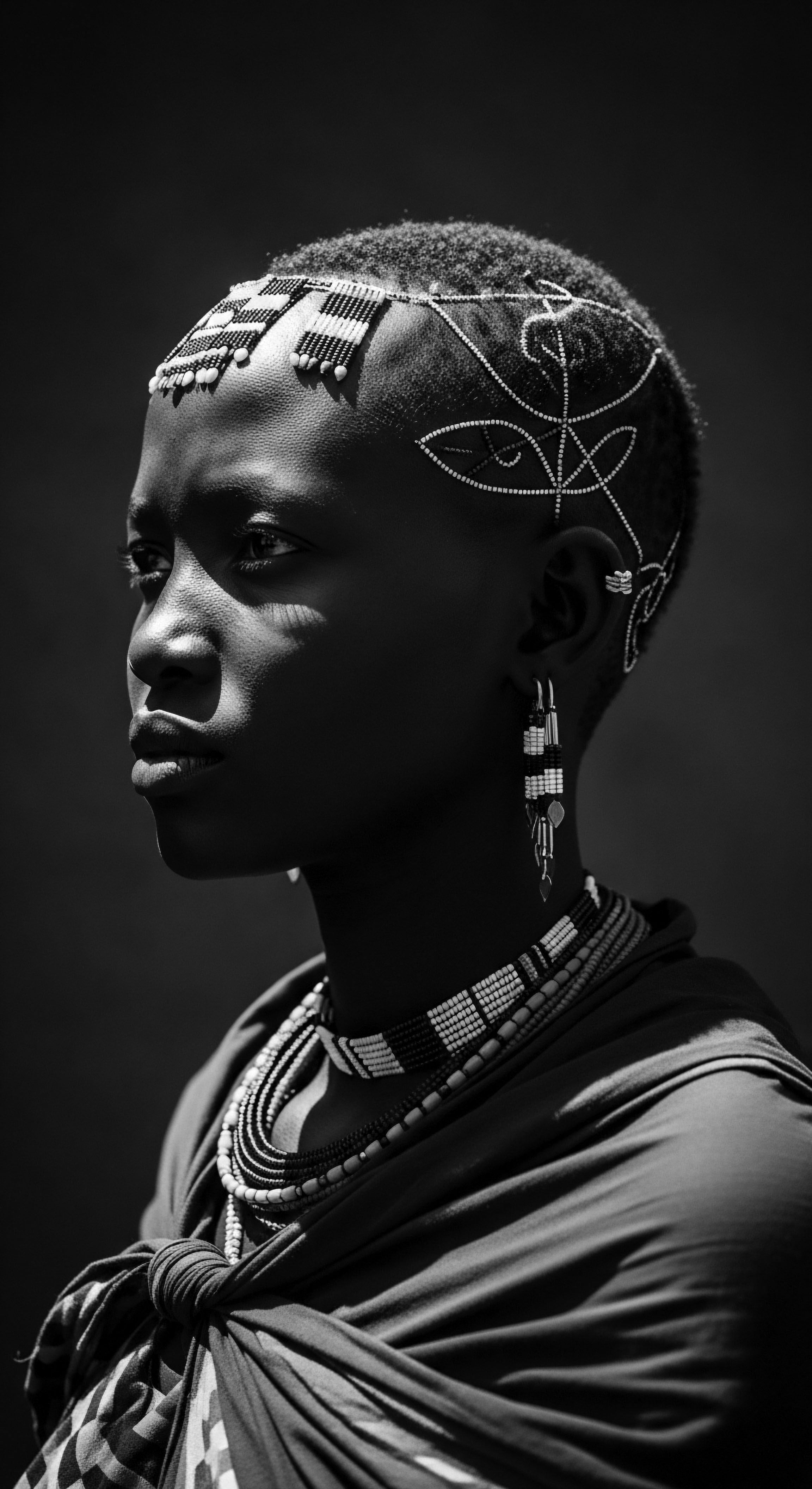
Roots
There are narratives etched into the very helix of our strands, tales not always spoken aloud but carried through generations, held in the curl, the coil, the wave. Our textured hair, in its myriad formations, is more than simply biology. It is a living archive, a sacred scroll detailing a heritage of survival, resilience, and profound ingenuity. To truly comprehend how ancestral hair practices influenced survival, we must listen closely to these quiet echoes, tracing them from the earliest human origins to the enduring legacies of today.
From the sun-drenched plains of ancient Africa, where humanity first bloomed, hair was a natural shield. Afro-textured hair, with its tight curls and coils, offered an evolutionary adaptation, protecting the scalp from intense solar radiation while allowing air to circulate, facilitating thermoregulation in hot, arid environments. (Noma Sana, 2024; Teknoscienze, 2023). This biological marvel became a cultural canvas, a foundational element of communal life.
Ancient African societies wove identity, status, and spiritual beliefs into their hair. Hairstyles served as a complex language, conveying age, marital status, tribal affiliation, wealth, and even religious devotion. (Afriklens, 2024; Odele Beauty, 2021; THE WELL, 2022). Skilled braiders, respected members of their communities, crafted elaborate designs, some of which held spiritual significance, believed to connect the individual to ancestors and the divine.
(Afriklens, 2024). The care given to hair was a communal act, a ritual strengthening social bonds and transmitting generational wisdom. This collective tending to hair was not merely aesthetic; it reinforced the very fabric of community, a structure essential for collective thriving.

What Basic Hair Structures Were Historically Significant for Survival?
The inherent architecture of textured hair, characterized by its tightly coiled structure, played a significant biological role. Unlike straighter hair types, the helical shape of coiled strands creates a dense, insulating layer, trapping air close to the scalp. This natural barrier offered protection from the scorching sun, minimizing heat absorption, a crucial function in climates where early humans lived. Scientific investigation confirms that tightly curled hair provides the most effective protection for the scalp against solar radiation, simultaneously reducing the need for sweat to offset heat gain.
(Teknoscienze, 2023; PMC, 2023). This inherent design contributed to the body’s ability to maintain a stable core temperature, directly impacting survival in challenging environments.
Beyond its thermoregulatory capacity, hair served as a physical buffer against environmental elements. Dust, debris, and insects, common in ancestral landscapes, found it harder to reach the scalp directly. The natural oils produced by sebaceous glands, often more effectively distributed along the scalp by the tighter curl patterns, provided a protective layer, sealing in moisture and guarding against dryness. These biological attributes, combined with intentional styling, laid the groundwork for practices that actively enhanced human endurance.
Textured hair, with its inherent coil and curl, offered foundational biological protection against harsh environmental elements, a testament to ancestral adaptation.

How Did Hair Practices Reflect Early Human Adaptation to Climate?
The relationship between hair practices and climate adaptation is deeply rooted in humanity’s journey across the globe. As early humans migrated and encountered diverse environments, their hair, a primary interface with the external world, became a point of adaptation. In regions with intense sun, like the African continent, tightly coiled hair provided superior solar protection, a form of natural sun hat.
Conversely, in colder climates, thicker, denser hair could offer insulation. This functional aspect of hair was understood, even if not articulated in modern scientific terms, by ancestral communities.
Practices arose that enhanced these natural attributes. Cleansing rituals using natural clays or plant extracts removed impurities and maintained scalp health, allowing hair to perform its protective duties. Oiling with plant-derived substances, such as shea butter or palm oil, served to moisturize the scalp and hair, preventing breakage and further safeguarding the skin. These rudimentary forms of care were not merely about cleanliness; they were about maintaining a vital protective layer, contributing to overall physical well-being and thus, survival.
- Shea Butter ❉ A traditional emollient from the karite tree, used across West Africa for its moisturizing and protective qualities, shielding hair and skin from sun and dryness.
- Palm Oil ❉ Utilized in many African communities for its conditioning properties, promoting hair strength and scalp health.
- Baobab Oil ❉ Extracted from the baobab tree, known for its rich nutrient profile that supported hair elasticity and vitality in arid climates.
The very act of gathering and preparing these natural ingredients fostered collective knowledge and communal activity. This sharing of resources and wisdom further strengthened social bonds, a subtle but significant factor in group survival. The hair practices of these early peoples were thus interwoven with their immediate environment, a testament to their deep ecological understanding and their ability to thrive.

Ritual
From the foundational understanding of textured hair, we step into the realm of ritual, where care became an art, a science, and a communal language. Ancestral hair practices transcended simple grooming. They embodied a living legacy, a dynamic interplay between technique and deeply held cultural values. This is where the tender thread of care, passed from hand to hand, generation to generation, truly began to shape group and individual survival.
The communal nature of hairstyling, particularly braiding, reinforced social cohesion. These were not solitary acts but shared experiences, often accompanied by storytelling, singing, and the transmission of wisdom. (Afriklens, 2024). Such gatherings solidified familial and tribal bonds, fostering a sense of belonging and collective strength essential for overcoming adversity.

How Did Collective Hair Styling Practices Reinforce Community?
The intimate act of hair styling, especially within Black and mixed-race communities, has always been a powerful expression of communal solidarity. Picture a circle of women, young and old, their hands moving with practiced rhythm, braiding and twisting. This scene, replicated across continents and centuries, represents more than just beautification.
It is a space where stories are exchanged, traditions are kept alive, and support networks are fortified. In times of profound hardship, particularly during the transatlantic slave trade and its aftermath, these moments of shared hair care became sanctuaries.
During the brutal era of slavery, when cultural identity was systematically attacked, communal hair styling sessions served as clandestine classrooms and meeting points. Knowledge of traditional styles and their deeper meanings survived through these practices. This ongoing connection to heritage, in the face of relentless dehumanization, provided psychological fortitude.
It was a form of silent protest, a means of preserving one’s dignity and cultural memory when everything else was stripped away. (Afriklens, 2024; Thrifts & Tangles, 2021).
The communal act of ancestral hair styling served as a vital cultural touchstone, fostering identity and strengthening bonds in times of systemic oppression.
This enduring tradition continues today, a vibrant part of Black and mixed-race family life. The shared experience of preparing hair for school, for special occasions, or simply for daily life, reinforces intergenerational connections, keeping the tender thread of ancestral wisdom alive.

What Was The Purpose of Protective Styling?
Protective styles, a hallmark of textured hair heritage, served multifaceted purposes, directly contributing to survival through their practical and symbolic functions. These styles, such as braids, twists, and locs, minimized daily manipulation of the hair, thereby reducing breakage and promoting length retention. This was especially vital when access to nourishing ingredients or proper tools was limited.
Beyond the immediate benefit of hair health, protective styles held deeper, life-sustaining implications during times of extreme oppression. In the context of transatlantic slavery, these styles became tools of resistance and communication. Enslaved African women, with remarkable ingenuity, would braid intricate patterns into their hair that reportedly served as maps to escape routes, or even to signal where water and safe houses could be found.
(Ancient Origins, 2022; Odele Beauty, 2021; Beds SU, 2022; Substack, 2025; Thrifts & Tangles, 2021; THE WELL, 2022; Black owned business directory, 2019). These styles were not merely decorative; they were cartographic representations of freedom, hidden in plain sight.
| Traditional Practice Braiding Escape Maps |
| Survival Mechanism Provided covert navigation for fleeing enslavement, demonstrating ingenuity in oppressive systems. |
| Heritage Connection The legacy of resistance and coded communication, a testament to the pursuit of freedom. |
| Traditional Practice Hiding Seeds/Valuables |
| Survival Mechanism Ensured sustenance and resources for escapees, aiding in the establishment of new lives. |
| Heritage Connection A symbolic carrying of agricultural heritage and future possibility, emphasizing resourcefulness. |
| Traditional Practice Headwraps |
| Survival Mechanism Protected hair from harsh labor and environmental exposure, subtly defying imposed beauty standards. |
| Heritage Connection A symbol of dignity and resilience, a rejection of Eurocentric ideals during slavery. |
| Traditional Practice These practices underscore how textured hair became a dynamic tool for survival and cultural preservation. |
A compelling historical example of this ingenious adaptation comes from the Maroon communities in Colombia and Suriname. Women among the Maroons, descendants of escaped enslaved Africans, would braid rice seeds into their hair. (Rose, 2020; ResearchGate, 2022; Substack, 2025). These seeds, often native West African rice varieties, were then planted in their newly formed settlements, providing essential food and agricultural knowledge for their survival as free communities.
This practice not only secured sustenance but also preserved vital agricultural heritage, linking their journey to freedom with the very earth they tilled. The oral histories of Maroon women in Suriname still recount how ancestors like Sééi, Yaya, and Paánza carried these life-sustaining seeds within their hairstyles, directly ensuring the establishment and perpetuation of their free societies. (ResearchGate, 2022).
The protective nature of these styles extended to hiding small, vital items. Gold nuggets from mines, or tiny tools, could also be concealed within thick braids, offering a means of exchange or self-defense. (Ancient Origins, 2022; Beds SU, 2022; Thrifts & Tangles, 2021; Colombia Travel, 2023).
The sheer practicality of these styles, offering a means of managing hair without access to conventional tools or products, made them indispensable for those working under severe conditions. They kept hair manageable, clean, and out of the way, minimizing discomfort and potential health issues.
- Cornrows ❉ A deeply rooted African braiding technique, later used by enslaved people for concealing items and mapping escape routes due to their close adherence to the scalp.
- Twists ❉ A versatile style that offers a protective barrier for hair strands, minimizing tangles and environmental exposure.
- Locs ❉ A long-term protective style, representing a spiritual and cultural statement of self-acceptance and connection to ancestry.

Relay
The legacy of ancestral hair practices, once a means of direct physical survival, transformed into a powerful relay of cultural identity and psychological fortitude. This is where the deep understanding of textured hair’s heritage moves beyond the elemental and into the complex interplay of history, society, and the enduring human spirit. The experiences of Black and mixed-race individuals, particularly, highlight how hair became a battleground for dignity, a canvas for self-expression, and a beacon of collective remembrance.

How Did Hair Become a Symbol of Resistance and Identity During Oppression?
During the transatlantic slave trade, the very act of shaving the heads of captured Africans was a calculated attempt to strip them of their cultural identity and sever their connection to their heritage. (Odele Beauty, 2021; Thrifts & Tangles, 2021; THE WELL, 2022; BLAM UK CIC, 2022). This dehumanizing practice aimed to erase centuries of meaning woven into hair, transforming individuals into anonymous commodities. Yet, despite such profound violence, textured hair became a resilient symbol of resistance.
The enslaved found ways to reclaim control, often through the re-adoption of traditional styles and the innovative use of readily available materials for care. Headwraps, for instance, initially worn for protection from harsh conditions and lice, evolved into powerful symbols of dignity and cultural adherence, subtly defying European beauty standards. (Afriklens, 2024; Odele Beauty, 2021; Wikipedia, 2022).
The concept of “good hair” versus “bad hair” emerged during this era, a product of Eurocentric beauty ideals imposed on Black communities. Straight, fine hair was deemed “good,” while coily, textured hair was labeled “unprofessional” or “unattractive.” This insidious hierarchy, known as texturism, affected the social standing and even the living conditions of enslaved people. (Odele Beauty, 2021; Wikipedia, 2022; Thrifts & Tangles, 2021; THE WELL, 2022; Noma Sana, 2024).
The pressure to conform to these standards, often through harsh chemical treatments like lye-based straighteners, became a survival tactic for navigating prejudiced societies, particularly in professional and educational settings. (Wikipedia, 2022; Noma Sana, 2024).
However, the spirit of resistance never truly faded. The 20th century witnessed powerful movements that reclaimed textured hair as a symbol of pride and empowerment. The Civil Rights and Black Power movements of the 1960s and 70s saw the widespread embrace of the Afro, a bold political statement rejecting assimilation and celebrating Black identity.
(Odele Beauty, 2021; Issuu, 2023; THE WELL, 2022). This movement inspired a redefinition of beauty standards, promoting self-acceptance and honoring African heritage.
The history of textured hair is a testament to unwavering resistance, transforming from a tool of covert communication to a powerful symbol of identity and cultural pride.

How Do Modern Hair Movements Reclaim Ancestral Wisdom?
The natural hair movement of today, though distinct from earlier periods of resistance, stands as a direct descendant of ancestral practices and the struggles of the past. It represents a conscious return to embracing the inherent beauty of textured hair, celebrating its versatility and its deep historical roots. This contemporary movement is powered by a collective desire to disconnect from imposed beauty standards and reconnect with a heritage of holistic care and self-acceptance.
Modern practitioners and wellness advocates draw directly from ancestral wisdom, advocating for natural ingredients and gentle care rituals. The use of traditional oils like shea butter and castor oil, herbal rinses, and protective styles that echo ancient methods are central to this reclamation. (Substack, 2025; Black Women Radicals, 2020).
These practices are not simply about aesthetics; they are about fostering a deeper connection to one’s lineage, promoting holistic well-being, and nurturing a sense of self-worth that was historically undermined. The conversation surrounding hair has expanded to encompass mental health and self-perception, acknowledging the profound impact of historical discrimination.
For example, the widespread adoption of bonnets and silk scarves for nighttime protection, a modern practice, resonates with historical methods of preserving hairstyles and maintaining hair health, albeit with new materials. Ancestral wisdom understood the need to protect hair from environmental wear and tear, and this understanding has been passed down through generations, evolving with available resources.
The ongoing dialogue about hair discrimination, leading to legislative efforts like the CROWN Act in the United States, further underscores the enduring fight for the right to wear one’s natural hair without prejudice. (Wikipedia, 2022; PMC, 2023). This struggle is a direct continuation of the ancestral fight for survival, where hair was, and remains, a visible marker of identity and a testament to an unbroken heritage.

Reflection
The whispers held within each curl and coil continue to echo through time, carrying the legacy of survival and the vibrant spirit of textured hair heritage. Our exploration has traversed ancestral ingenuity, communal solace, and acts of profound resistance, all centered around the very fibers that crown us. The story of how ancestral hair practices influenced survival is a testament to the enduring power of human connection, cultural preservation, and the indomitable will to thrive against overwhelming odds.
The ‘Soul of a Strand’ ethos reminds us that hair is never merely static; it is a living, breathing archive. It carries the wisdom of those who came before us, their adaptations to climate, their coded messages of freedom, and their unwavering determination to preserve their identity in the face of brutal oppression. By understanding these deep historical roots, we not only honor our ancestors but also gain a richer appreciation for the resilience embedded in our own textured hair. This understanding is not an academic exercise; it is a profound journey of self-discovery, inviting us to see our strands not as a trend, but as a continuous, sacred narrative that connects us to a past of strength and guides us toward a future of unbridled self-acceptance and celebration.

References
- Afriklens. (2024, November 1). African Hairstyles ❉ Cultural Significance and Legacy.
- Ancient Origins. (2022, November 30). African Slaves Used Braids to Communicate Escape Routes in Colombia.
- Beds SU. (2022, October 7). Black History Month 2022 ❉ The History Behind Cornrows.
- BLAM UK CIC. (2022, September 15). The history of Black Hair.
- Cultural Survival. (2020, September 30). Honoring the Spiritual Legacy, Resiliency, & Healing Power of Our Ancestors Through Indigenous Customary Hair Traditions.
- Issuu. (2023). Celebrating the history and beauty of afro-textured hair.
- Noma Sana. (2024, October 30). The History of Straightening Afro and Textured Hair.
- Odele Beauty. (2021, February 22). 6 Things Everyone Should Know About Black Hair History.
- PMC. (2023, August 2). The Person Beneath the Hair ❉ Hair Discrimination, Health, and Well-Being.
- ResearchGate. (2022, November 19). Maroon women still grow rice varieties named after their ancestors who hid seeds in their hair when they escaped slavery in Suriname.
- Rose, S. (2020, April 5). How Enslaved Africans Braided Rice Seeds Into Their Hair & Changed the World.
- Substack. (2025, May 4). Ancestral Hair Rituals to Nourish Your Hair and Soul.
- Teknoscienze. (2023, August 4). Human scalp hair as a thermoregulatory adaptation.
- THE WELL. (2022, February 10). What Everyone Needs to Know About Black Hair History.
- Thrifts & Tangles. (2021, December 16). The Evolution of Black Hair for Beauty & Resistance.
- Tourism Colombia Travel. (2023). Traditional hairstyles and drums.
- Wikipedia. (2022). Discrimination based on hair texture.
